Not only had I planted our tent right in the cold, moist, wind, but I also failed to realize what that would mean, scientifically speaking. With each exhalation, Ambrose and I created a pocket of warmth inside the tent. The cold, moist air blowing across the pocket of warmth naturally condensed. This condensation not only collected on the interior ceiling of our tent, but also on the tree branches overhanging the tent. Eventually, so much condensation was being built up in the trees above us that Ambrose and I were both convinced it was actively raining outside the tent. Why else would it be so wet inside?
After we had gotten changed into hiking clothes in the morning, we left the tent to find it was not, in fact, raining. At least, it had only been raining on our tent…
It was another 4 am wake up call. We were hoping to make it to Shi Shi Beach in one tide cycle, but I had no idea how realistic that would be. Low tide this morning was quite early, so the earlier we could leave, the better.
Leaving North Ozette, there is first a long stretch of damp sand that’s nice to walk on. The only downside to it being so nice to walk on is that it goes by quickly. Before long, we were forced into a choice between the low wet and the high dry. The low wet was particularly slippery looking, so we mostly hiked on the high dry side. At this point, that surface is billiard ball size rocks, crunching underfoot, with occasional downed trees to navigate around. A pain to hike on, but not super complex.
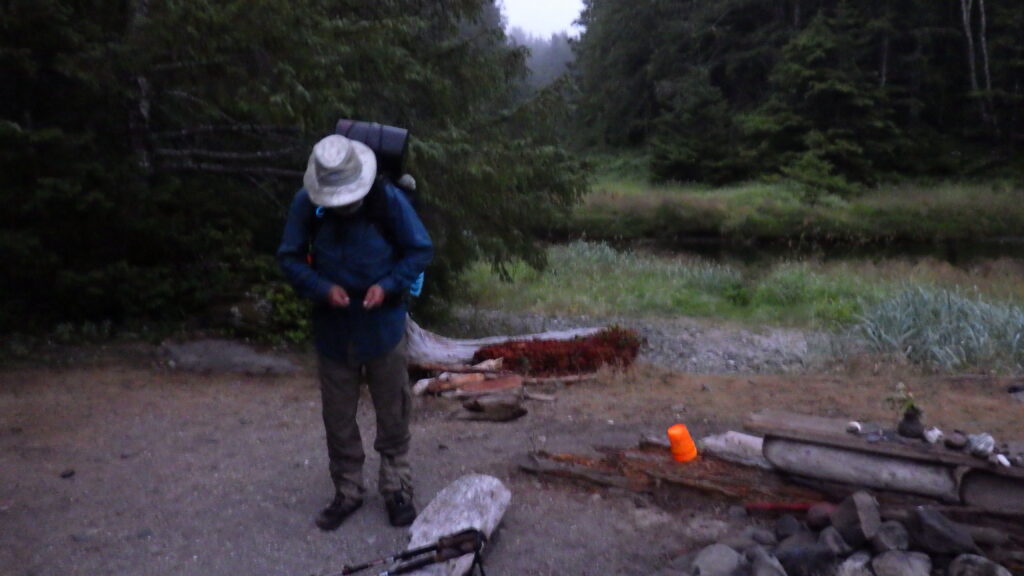
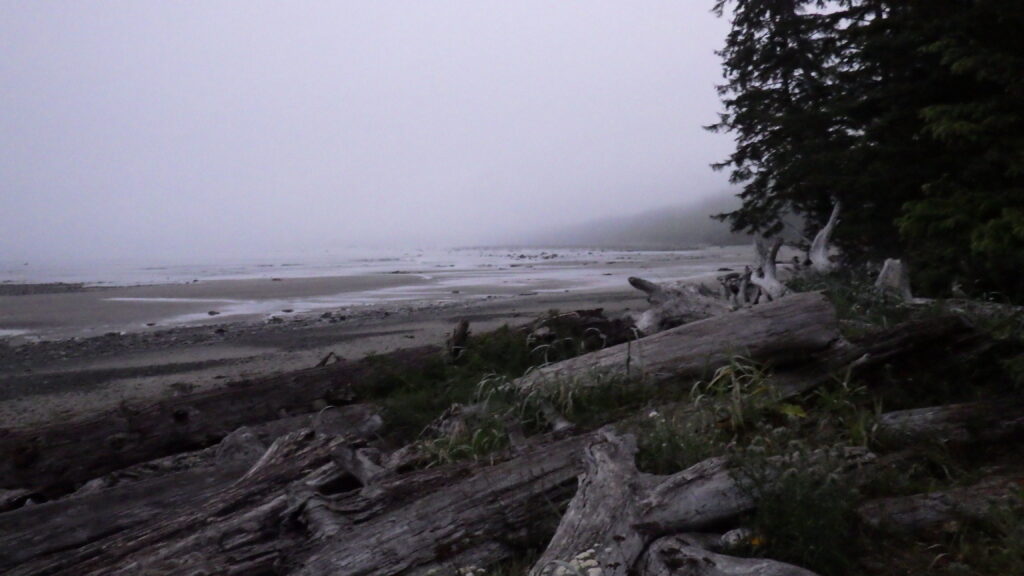
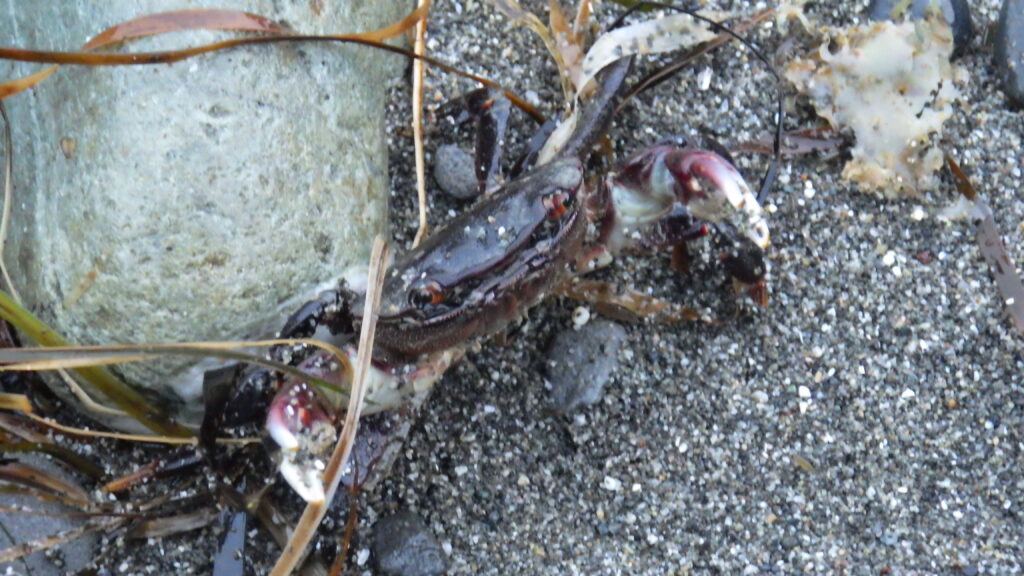
And just before Seafields, the surface starts to get sandier so it’s a bit easier to walk. That allowed me to scan the bluffs high above for houses. At Seafields, there are several houses still under lease. My understanding is the Forest Service has not been renewing those leases as they run out, with the plan to turn the whole thing back into wilderness once they’re all gone. In the meantime, there are some amazing houses out there, as well as an easy access point for cars.
There were people camped at Seafields, but not up on the bluff. I didn’t think there was space for them to camp down on the beach with the tide, but there was a tent snugged right up under the bluff. People were just starting to stir as we hiked by.
Past Seafields, we had a bit of a mix of damp sand and rocky beach. There started to be more boulders blocking the way, which we needed to navigate around. I mean, we could have climbed over one or two of them, but we were avoiding climbing until we absolutely needed to do so.
With the tide first going out, and then being very low, the sound of the waves didn’t often penetrate over the crunching of our steps. The wind was near constant and moist, blowing in our faces. While I knew that the coastline turned ahead, I couldn’t see it through the morning marine layer of clouds. Slowly, as we got closer and closer, the outlines of the bluffs ahead grew from dim outlines to dark outlines.
And then, I discovered exactly why we got up at 4 am.
The first time we hiked this way, we had to keep close to the bluffs because the tide was higher. We ended up holing up on the rocks for the high tide, and when it passed we had a ton of scrambling to do over high rocks (though we could have waited for the water to get lower, we were running out of daylight on that trip).
This time, we were able to cut out that whole corner, because there was a huge expanse of damp sand exposed. We didn’t walk close enough to that alcove to properly identify it, though I was pretty sure I knew when we passed it at a great distance.
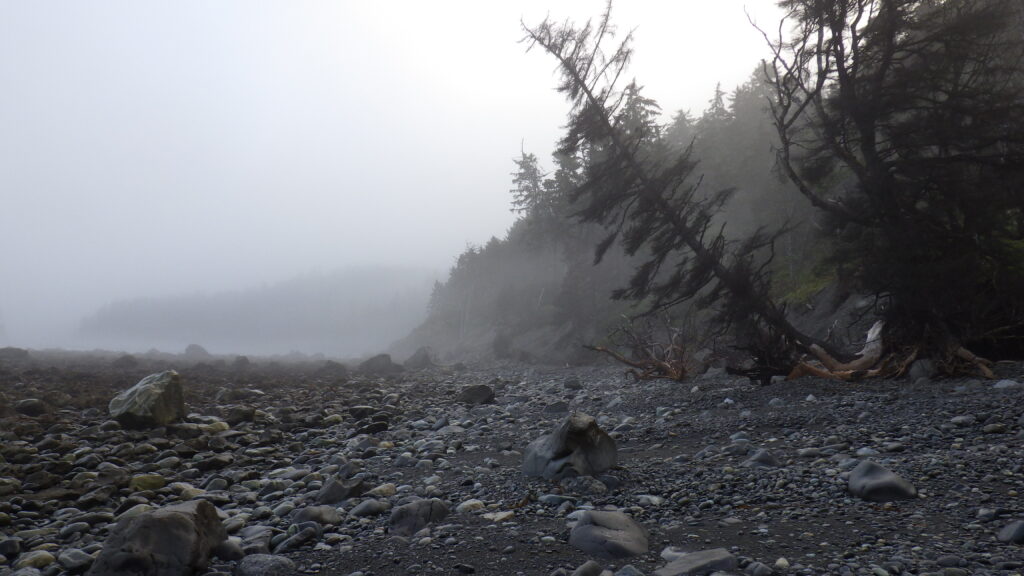
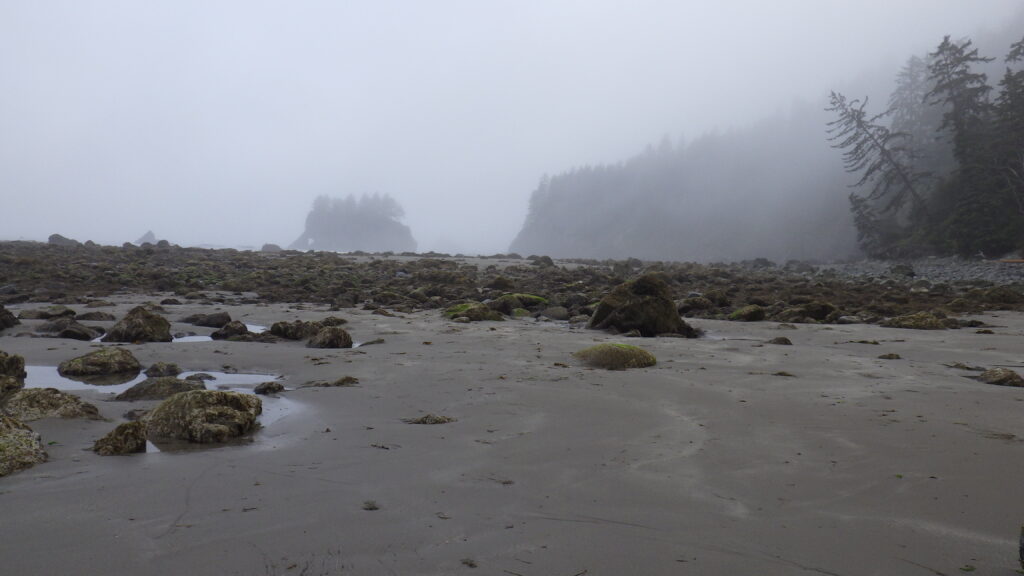
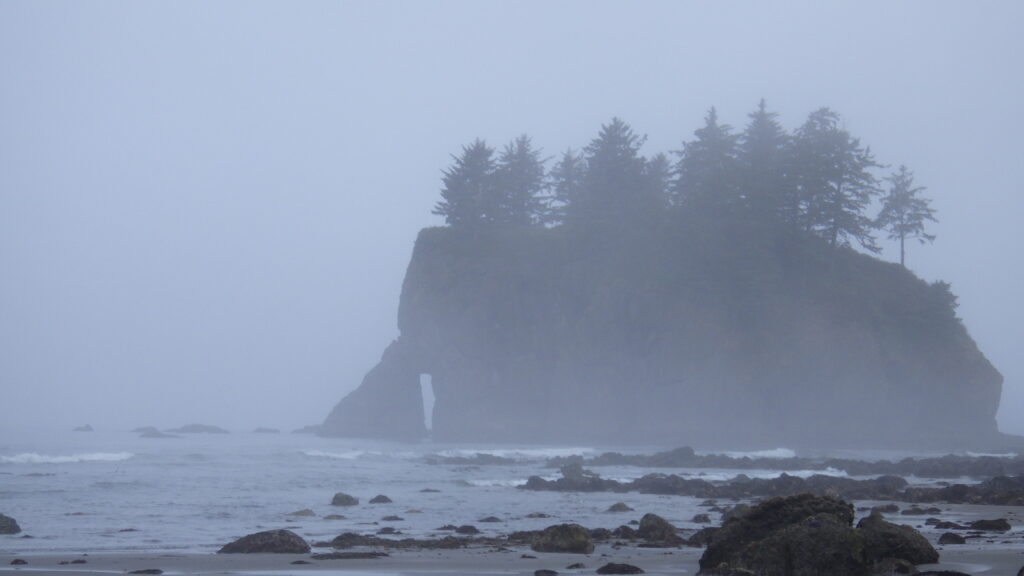
The expanse wasn’t perfect; there were seaweed strewn rocks scattered through the sand, along with flows of water and little tide pools. We did have to navigate through the damp sand. But it was so much easier than hiking on rocks, the detours hardly mattered.
When we finally ran out of sand to walk on, we did still have a chunk of rock scrambling left to go. I tried to avoid a lot of going up and then down, but at this point we didn’t have a lot of choices. The advantage to the high road was that the rocks were drier, and often covered with a crust of some creature that gave decent footing. The advantage to the low road was that we could put our feet on the ground, sliding to firm footing as needed.
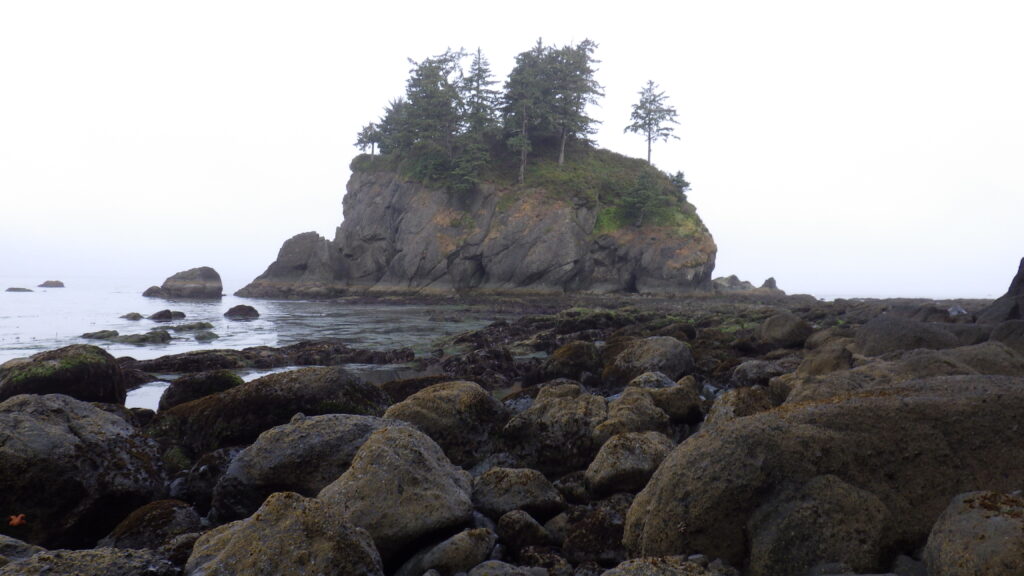
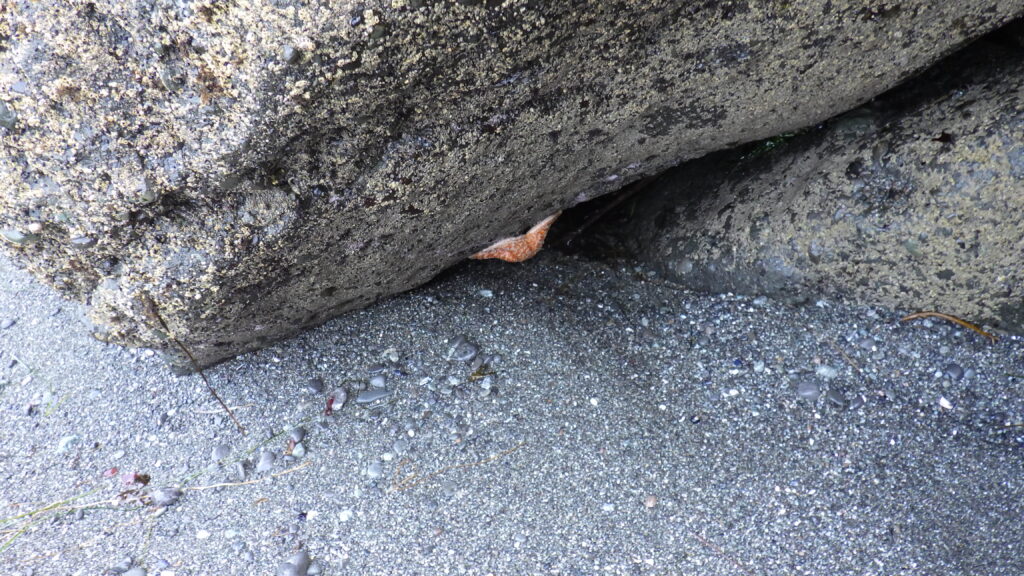
I personally liked the high road better, but I managed to pull my groin a little bit on one of the rocky transitions, which meant the low road was safer not only for me, but for Ambrose and his healing ankle. The groin pull was irritating, but not debilitating. Ambrose did ask me if I wanted to stop, but we were in the middle of the rocks. There wasn’t anything to do but press on. I took extra care with my steps and managed to keep moving. But Ambrose did take the lead.
We made our way around that point and onto a rocky beach. This one had a rope dangling at the opposite end. And this was the one that I’d been looking forward to since 2018.
In 2018, Bill went up the rope first. He made short work of it. Then Ambrose went.
The start of this particular overland trail is nearly vertical. It’s a tough scramble, no matter what, especially carrying a backpack. And when you are carrying a significant amount of excess weight, it gets even harder. In 2018, I had to give Ambrose a boost to get him past the vertical part.
Not this year, no siree. 80 pounds lighter than in 2018, Ambrose was able to get himself up that rope. He did have a bit of a rough time, but that was more technique. He later figured out from watching me that leaning into the rope and holding it close to his body provides more security and makes it easier to move.
I was incredibly proud of Ambrose making his way up that rope. Years of hard work and discipline led to that moment. It is proof positive that you can increase your fitness at any age. I used to think (when I thought of it) that getting old meant not being able to be active anymore, but between CrossFit and my husband, I know now that’s not true.
I had problems of my own getting past the steepest part of that ascent, but I was able to learn from watching Ambrose. It was hard, but I didn’t take too long. This was the first overland trail between Seafields and Shi Shi, and I knew we had two more overland trails to go. But they weren’t as difficult as this one. One of them didn’t even need to have a rope at the start!
We made our way up and over this one in pretty short order, heading down to the next beach, where, to our great surprise, there was not another overland trail. No, we had another point to traverse before we would be able to continue. And this rocky point was no joke.
Ambrose led the way, because my brain was tired from leading on the last point. It started out no worse than any other area that we’d hiked, but when we approached the pointiest point of the point, we had a choice. Wait for the tide to reveal the low road again, or go high.
Ambrose chose high.
When I’m there, I don’t think about how dangerous it is. I just see that I need to get from A to B, and that will mean climbing straight up a sea-damp rock, maybe 40 feet above the rocky ground, where a fall would seriously injure me, if not outright kill me. But looking back on the video that I took of this section, it’s breathtaking how precarious this section of the trail was.
I mean, yes, I was scared at the time. Scared enough to take great care in how I moved, and the placement of my feet. And I avoided looking at where I’d fall if I were to lose my footing.
The climb up was a lot harder than the climb down for this section. Thank goodness! The biggest worry I had while climbing up (since I wasn’t thinking about falling) was that we’d find a sheer cliff face on the other side and have to backtrack.
Instead, we made a much slower descent, turning to get to the next beach. This beach was also rocky, with no sand, just tiny pebbles that sucked our feet in with each step. The next point would be crossed by an overland trail, but the access to the overland trail involved a whole lot of rocks.
After we crossed the rocky beach, we had to strike out onto bigger rocks. Those rocks got bigger and bigger, and we had to step from one to the next to get to the overland trail. The last time we were there, in 2018, this overland trail had a large, pretty flat rock as a kind of platform. Now, that rock had shifted, tilting so that the platform no longer felt very safe. I mean, it wasn’t going to be moving any time soon, but it felt like it could.
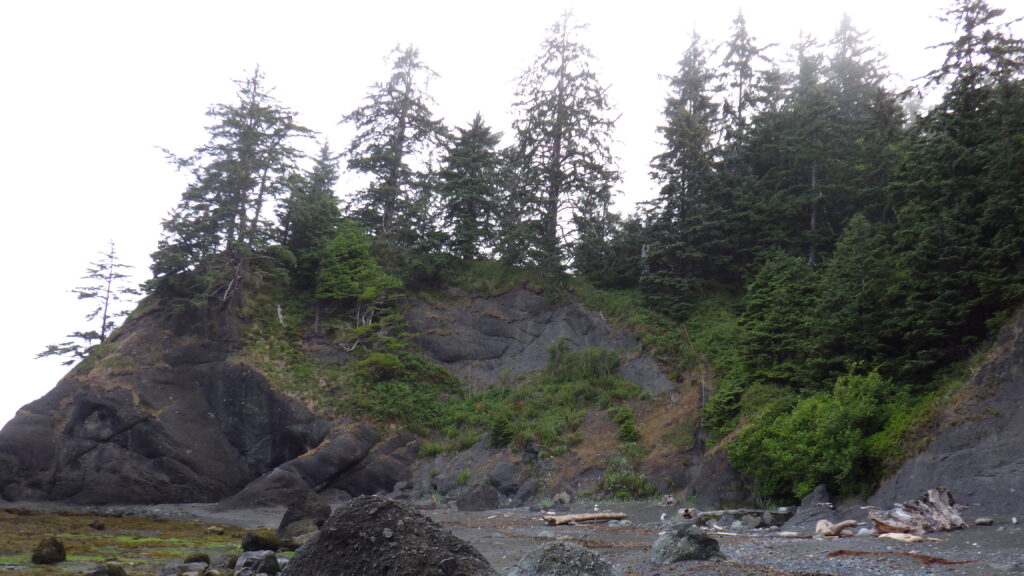
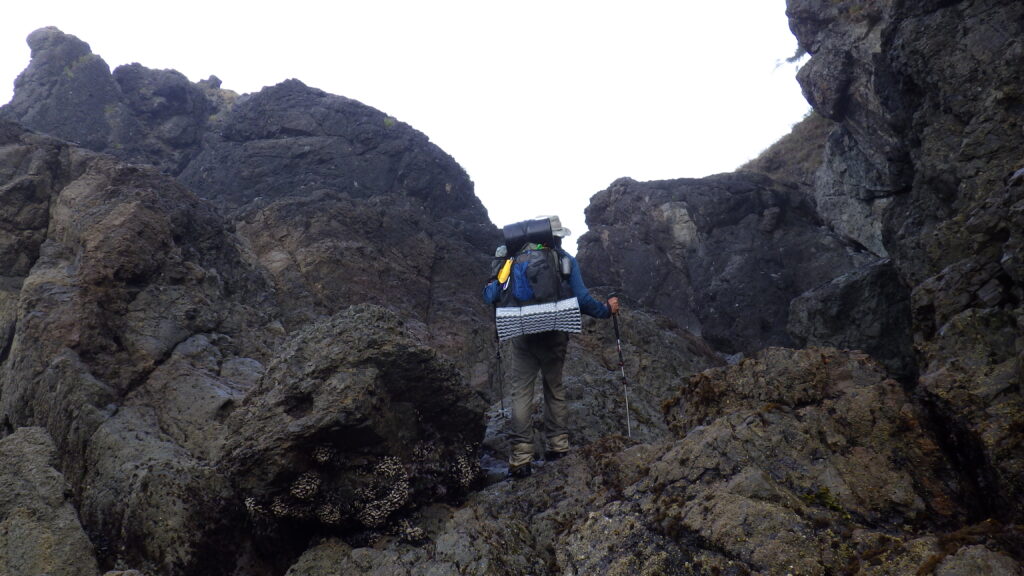
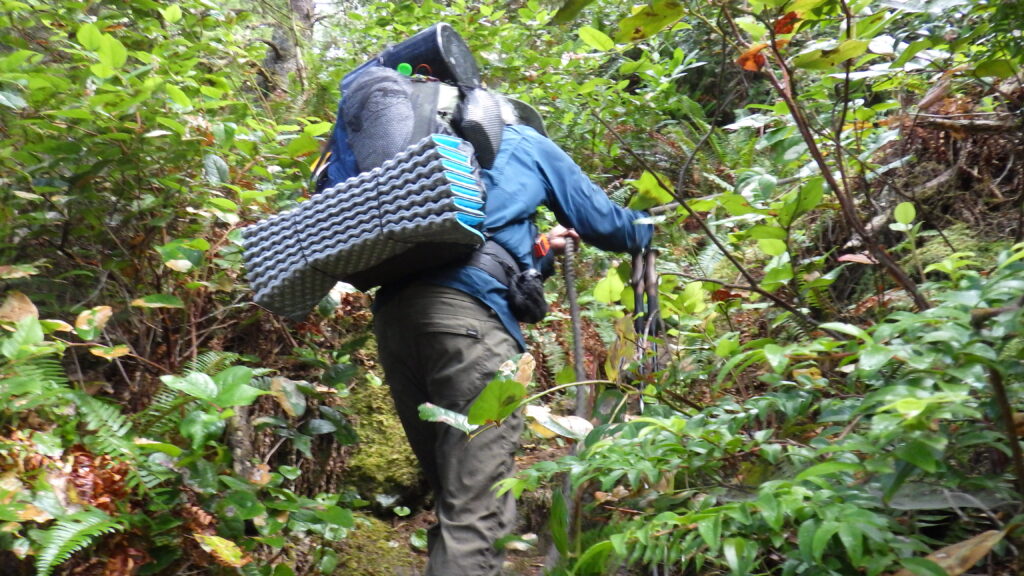
A short rope up a tree brought us to the START of this overland trail. This one was the big one. Not the longest, not the last, but the steepest. Oh sure, we’d walk on flats for a bit, but then I’d spot another rope lying in the dirt. We climbed over logs, and under logs. We got a little lost, taking an old trail.
And we discovered why that trail was rerouted. It’s because the original route, the one we ended up taking, is in the process of collapsing. We nearly couldn’t climb out of the other side, and we had to walk a narrow section with a black hole gap on one side. Oh, and don’t let me forget to mention that the ground up here is an aggregate of detritus. It’s solid when our boots step on it, but our trekking poles can pierce it, letting it get buried halfway up its length. That doesn’t happen every time with the trekking poles, but often enough to get me into trouble.
Up, up, and up we climbed. Rope after rope. I wanted to wait to take a break until we had reached the top. When hiking uphill, I prefer to break at the top, rather than take a break and have to go uphill again. Can’t always do that, but when I can, I do. Especially when I know I might want to dig a hole once I stop moving.
I don’t know exactly how high we had to hike, but we were both more than ready for a break by the time we reached the top. Or near enough that I was willing to stop anyway. We had a nice stop. While we had been hiking up, the marine layer had cleared up. Blue skies peeked out from between thickly entwined tree branches. I carefully found a place to dig my hole, watching out for holes and making sure I could find my way back.
In thick forest, finding your way back after a body break isn’t a laughing matter. A woman actually died while hiking the Appalachian Trail when she couldn’t find her way back to the trail after going off to dig a hole. They found her body only a couple hundred yards from the trail. That’s one advantage of hiking with a partner. One of you can stay with the trail while the other wanders off into the trees, and then you can do a “Marco? Polo!” to get back (which I did).
The trail trended a little up and down after our break, but no more big climbs on this side of the overland trail. We did have to keep an eye out for the orange flags that mark the path, and I remembered one section in particular, where we climb down into a little valley and then up the other side with a roped tree.
The route down to the next beach was roped, but I skipped the rope for most of it. I just used my trekking poles and scooted down. I recognized the beach when we arrived as the one with the stream. This would be our last fresh water before Shi Shi beach. After making my way through the mini maze of driftwood logs that are strewn across the beach, I saw the stream was flowing nicely. I kept going, following the trail up until I ran into a rope. Then I paused.
I realized in that moment that we were probably going to want to eat lunch somewhere up on this overland, and that we wouldn’t want to be coming back down here to get water. Better to get water now. Ambrose wasn’t too far behind me, and I told him to turn around.
It was awesome, actually, because in 2018, he wouldn’t have done it. He would have pressed on without water or let me go fetch it rather than turn around and climb back down what he’d already climbed up. This year, no worries. He just turned around and we made our way to the stream, finding a nice little spot to set up our filtration.
I went and filled the water bags while Ambrose did the filtering. The sun was kind of out, but our spot was in shade and I was getting chilly. I tried stretching my groin out, carefully, and watched the ocean while Ambrose did the work of getting our water ready for drinking. There’s a whole process to it, and over the years we’ve refined our system.
While we started out backpacking together using a pump filtration system, we quickly converted to the Sawyer squeeze filters. We moved on from the bags Sawyer sells to more durable ones, and learned that backflushing the filter after each use keeps the filter flowing well. They still work when they’re not flowing well; it just takes a much longer time for the water to get filtered. It’s really worth the little extra step of backflushing to keep the filters at top speed.
After Ambrose got both our water bags filled, and the water filter backflushed, we headed back up the trail we’d so recently descended. This time we continued hiking when we reached the rope, laden with full water bags. I was in the lead, so I was able to film Ambrose coming up and over the log at the top of that particular section.
When we got to the top of that section, we found ourselves walking through tunnels of bushes. Tunnels that were trying to close… And tunnels that had hidden tricks and treats. Tricks included surprise logs to step over or crawl under, and the treats included a few beautiful lookouts just off the trail.
As we continued hiking, we both got a bit concerned about finding a good place to eat lunch and wait out the tide. I found a kind-of maybe spot, but it lacked a good space to spread out, and we’d have to take care not to walk out onto the duff cornice.
I came to a split in the trail, and told Ambrose to wait while I explored one way. Well, I didn’t find anything that way, and hurried back after taking what felt like too long to not find anything. My excursion did convince me that the trail continued this way and the other fork was old trail or a game trail. But when I found Ambrose he was impatient, and I got frustrated. I told him to follow me and started back on the trail with a thrust of my trekking pole!
Into the duff, which parted for it so quickly that I was on the ground before I realized what had happened.
I took a moment, there on the ground, to analyze my body. I didn’t even feel like I’d fallen. The duff was very soft, and I’d managed to avoid landing on anything hard. I had a little trouble levering myself up since my trekking poles were sunk into the duff layer, but I got there. And then I continued along with a bit of a lighter step. I mean, it was pretty funny.
I was hiking ahead, and I finally came to a place that seemed like it would do. It would be cozy, but I didn’t have a problem with that. And we’d have views north and south.
Ambrose arrived and agreed to stay, after I reminded him that if we went down, we’d likely get stuck somewhere not as congenial.
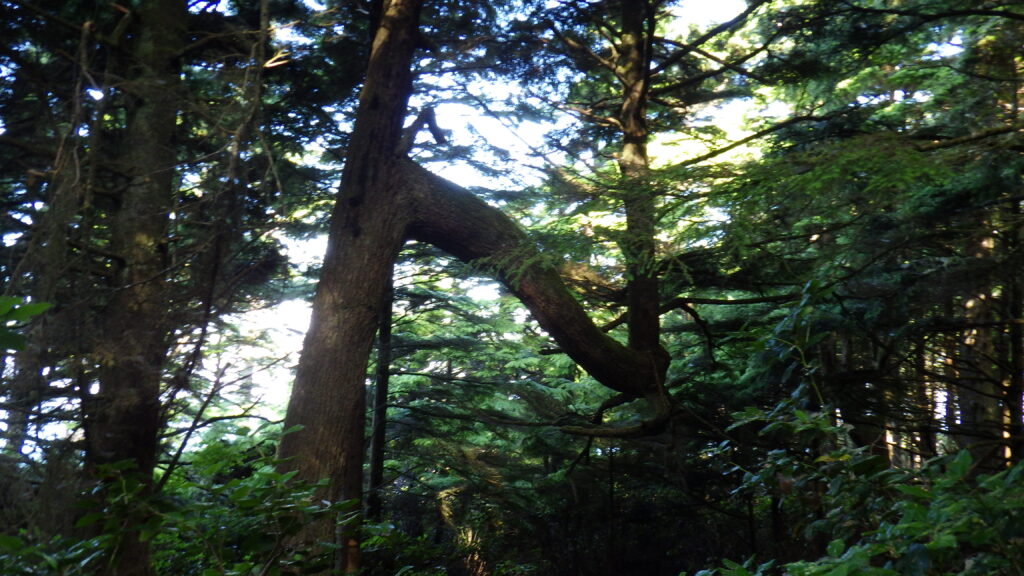
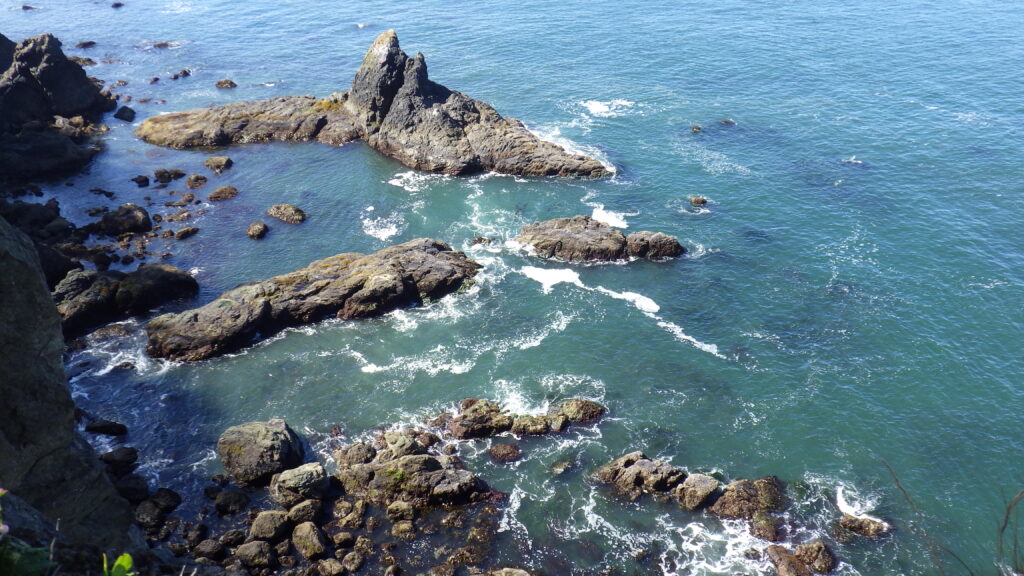
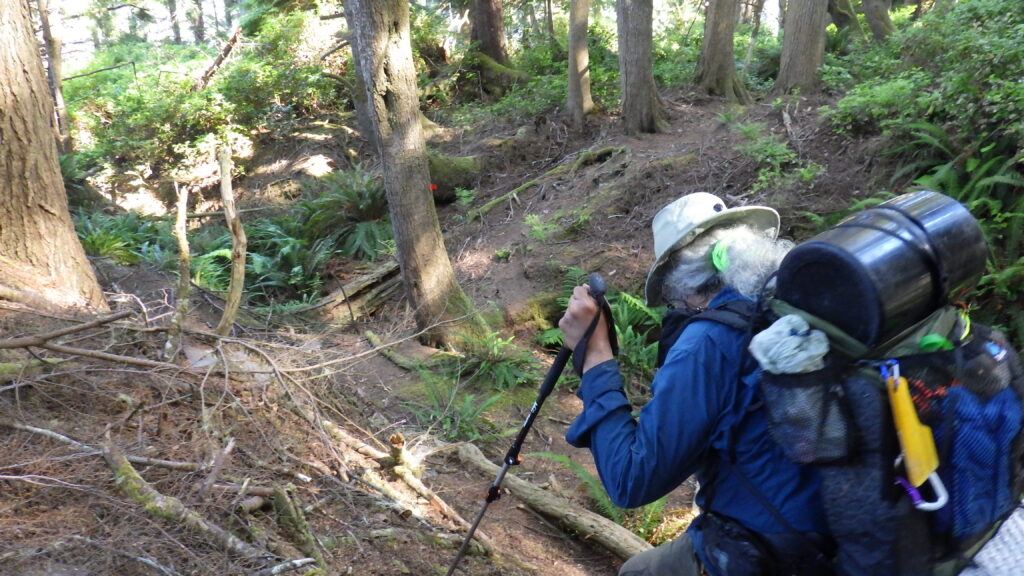
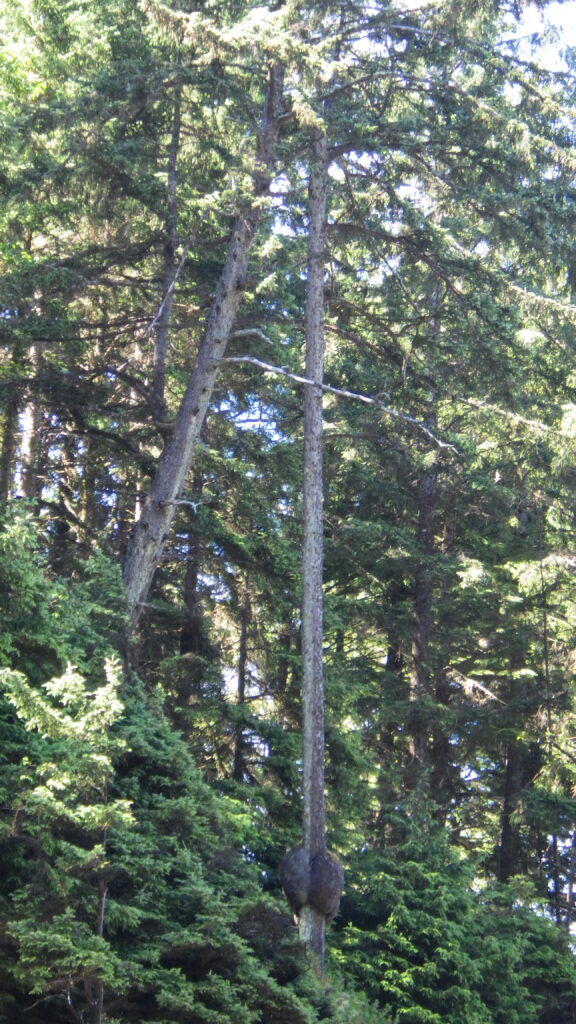
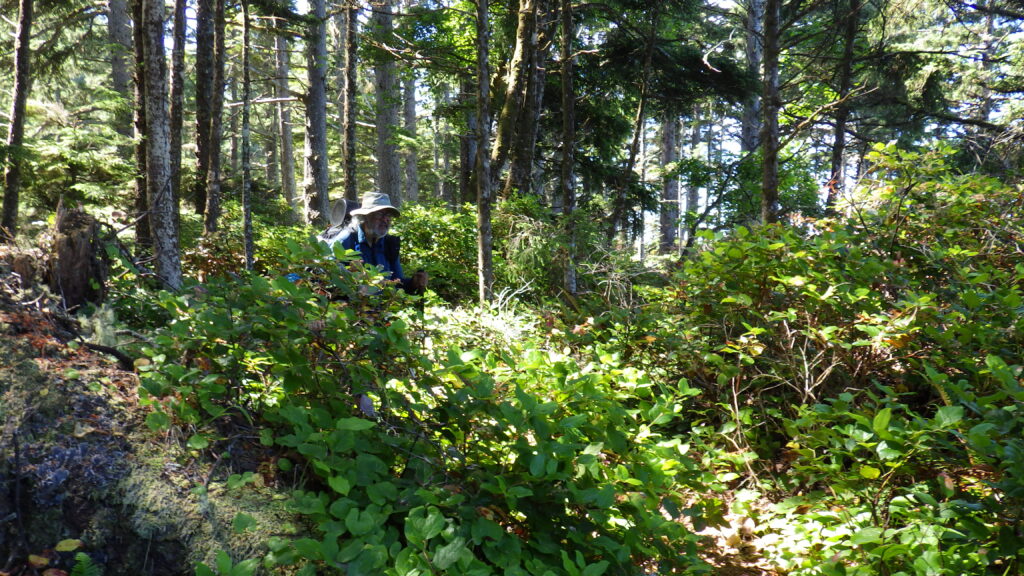
We set things out to dry, put our sleeping pads down for sitting, and got lunch ready. And we talked about the trail ahead. I kept saying Shi Shi was “just around the corner” but I was pretty sure there were two, maybe three corners until we got to the beach.
When we first arrived, I could see clouds over Cape Alava. And a few hours later, clouds encompassed our little point, coming from both sides to obscure our views. The sun overhead was still shining on us, but that wasn’t to last long.
It was close enough to time to head out, and so we packed up and headed down the trail to the next beach. This was one of the harder sections. The last bit of the trail is down a roped rock crack that gets swamped every tide. It wasn’t fun or easy last time, and this time, we discovered that the rope ended a good 8 feet above the level of the beach.
Now, it isn’t straight down. It’s possible to navigate, but it’s a whole lot scarier when you’re scooting down on wet, slick rocks with no rope to hold onto. We both tossed trekking poles rather than try to deal with them on that section.
But we both made it safely.
We made our way along the beach, and around the next point. The tide was going out, but still high enough that we had to time our steps to get onto the next beach. Then we were able to cut through a hole, as long as we could stand sharing the space with a rotting animal corpse. It stank so bad! And Ambrose managed to slip and immerse his gaiter in the rot, poor man.
We had but one more point to traverse, after another rocky beach walk. But when we arrived, we were too early. Maybe, maybe we could have hiked on if we were willing to walk into water up to our knees… but that wasn’t necessary when the water would fall sufficiently within 30 minutes.
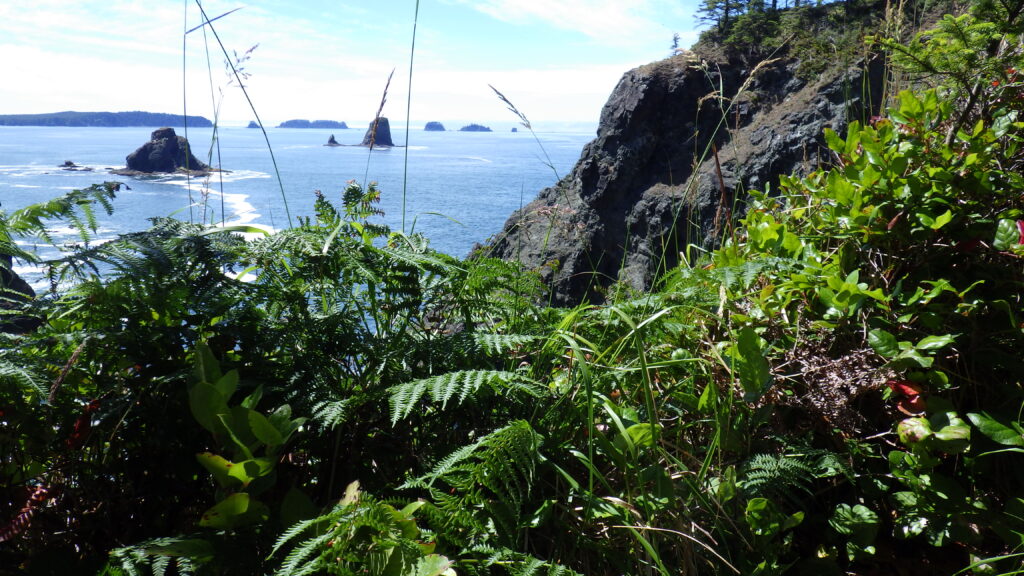
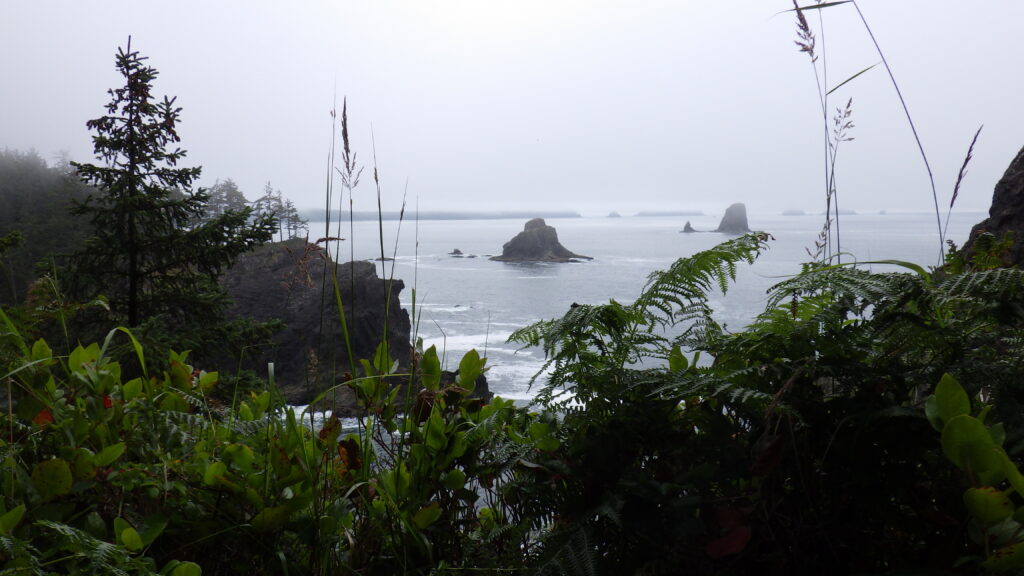
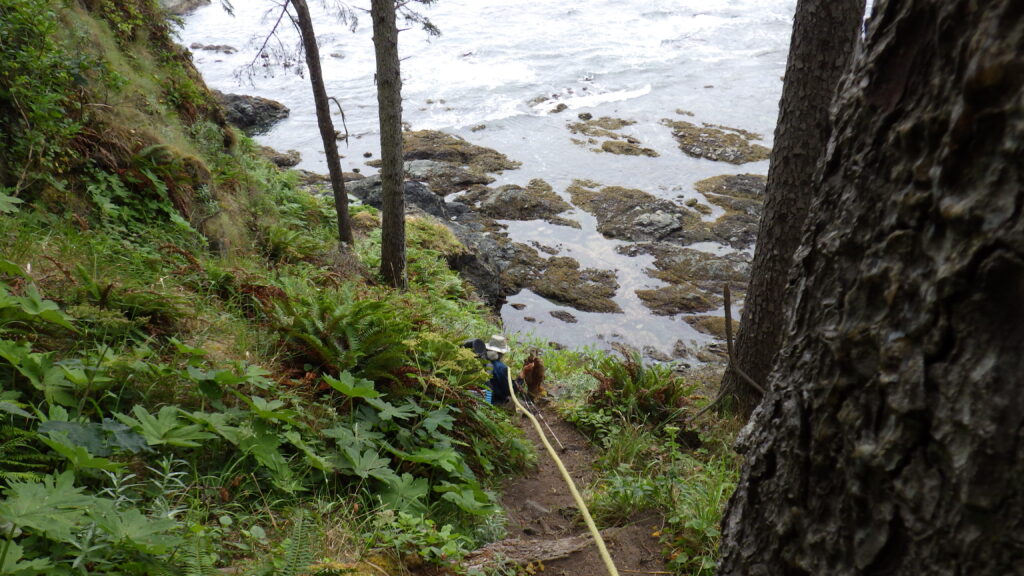
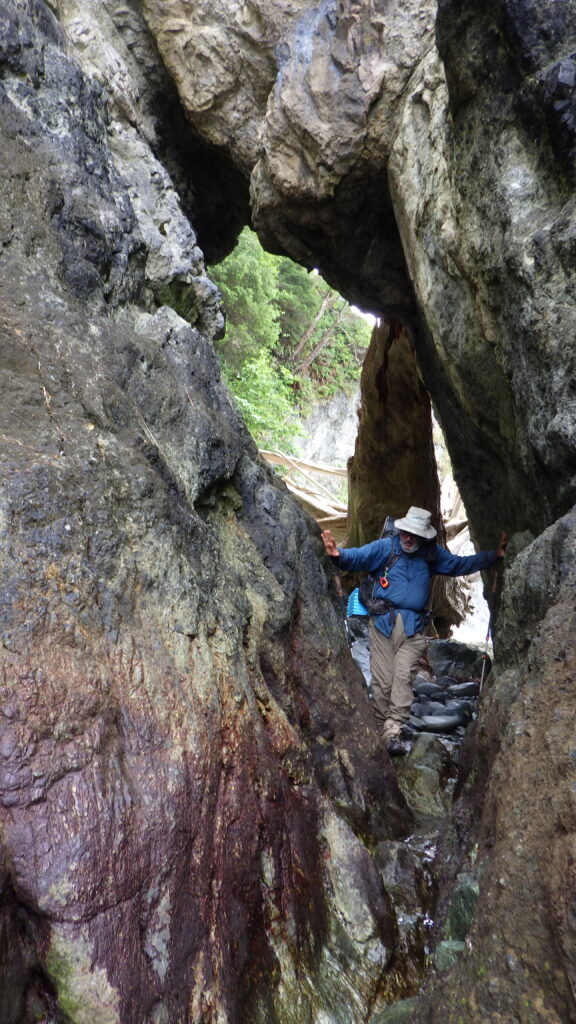
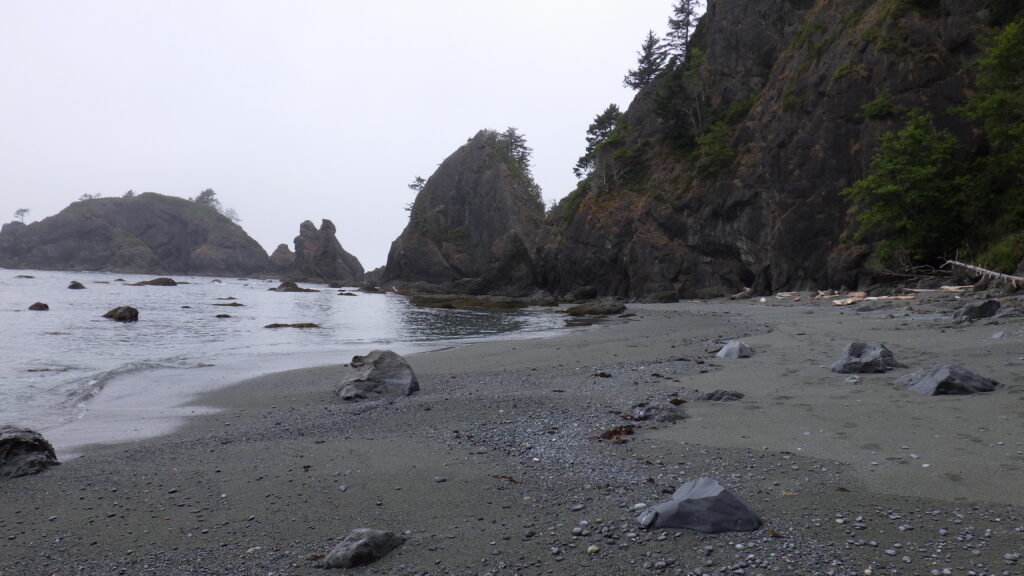
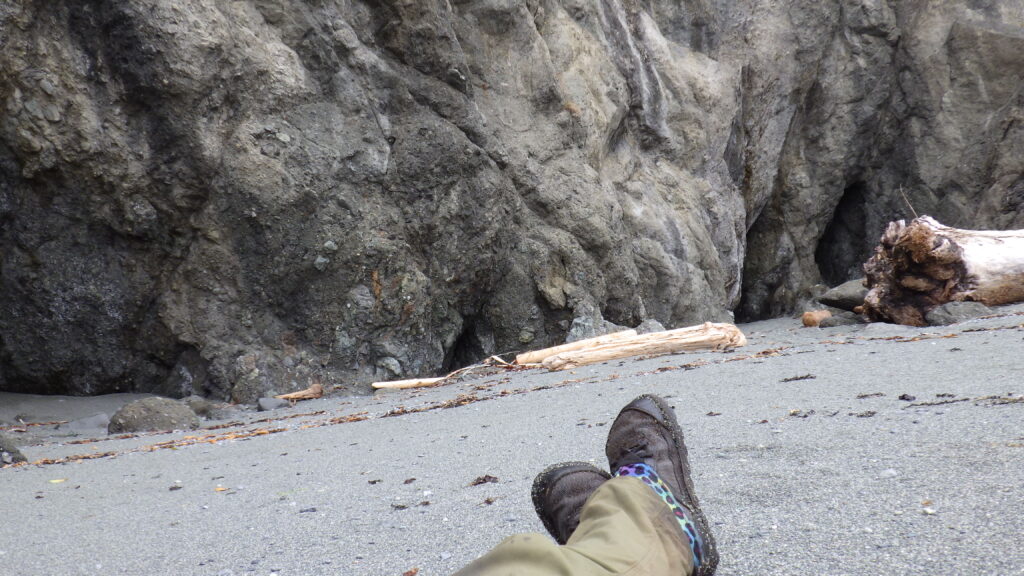
Which it did. We made it to the nice damp sand and then hiked through to Shi Shi Beach. At last!
It was still afternoon, and, unlike the last time we’d arrived at Shi Shi, the beach was nearly empty. Turns out, arriving on a Sunday instead of a Friday makes a significant difference. Or it could have been the cooler weather. I might never know, but I appreciated that we had our pick of campsites.
I walked us over to the closest campsite, claiming a fire ring that we wouldn’t use, along with an area up in the woods, and several driftwood benches. No swing, but I’d already had one with a swing. I’d survive.
After doing camp set up chores, we took a hike over to the privy together to make sure we knew the route. Better to know where you’re going before you really need to. It’s not that the privy is particularly hard to find, not if you know what you’re doing, but the entrance to it lies beyond a veritable maze of haphazardly piled driftwood. It’s the route that I wanted to practice.
I determined it was easier to navigate to the campsite next door to the privy, and then take the trail from the campsite to the privy, but that would only work if the campsite was unoccupied.
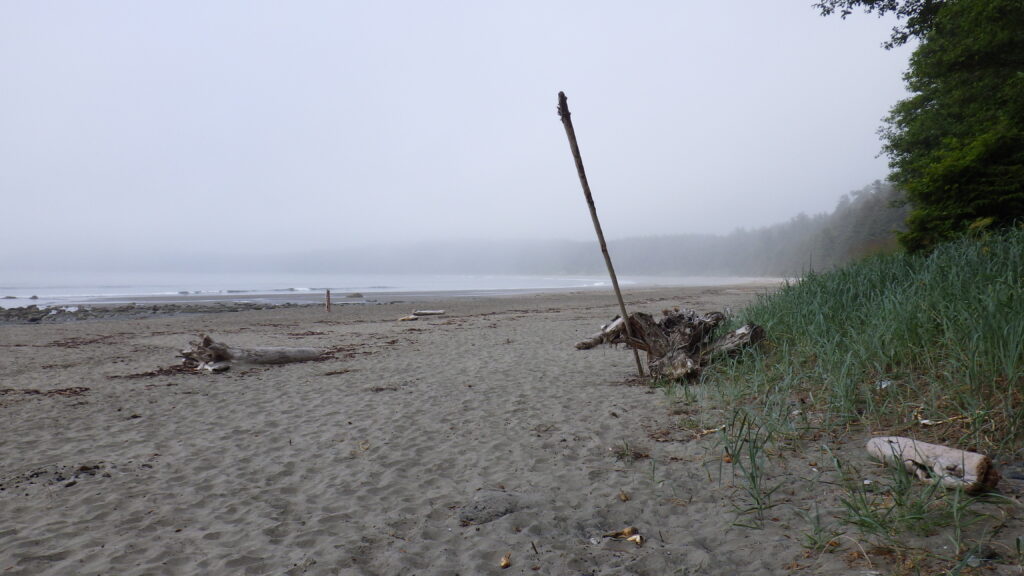
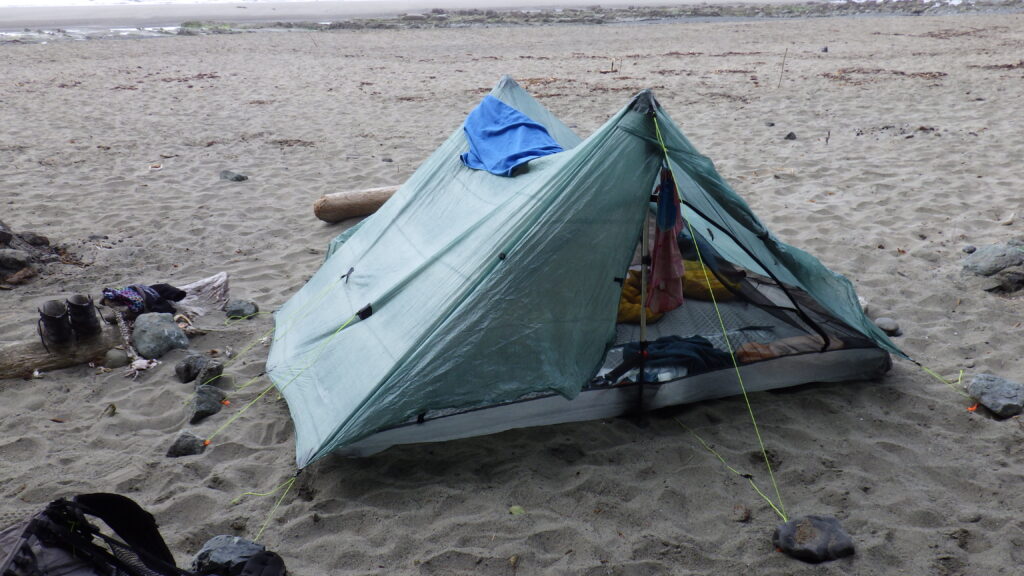
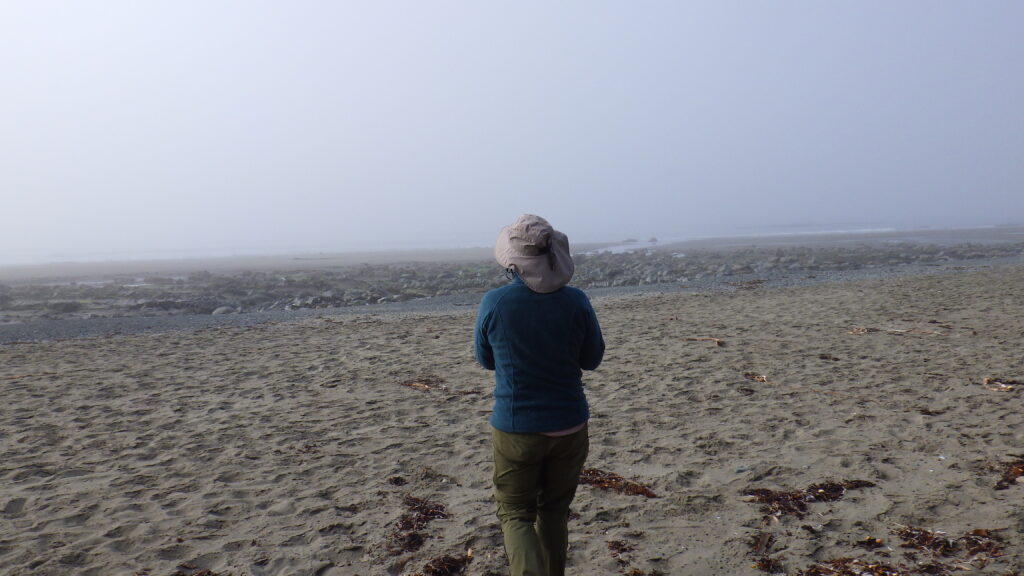
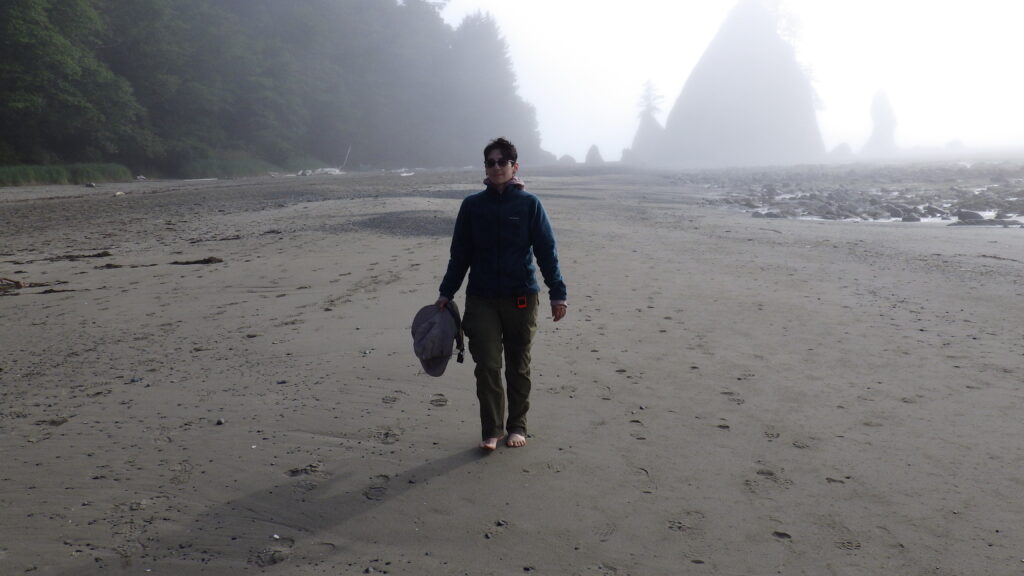
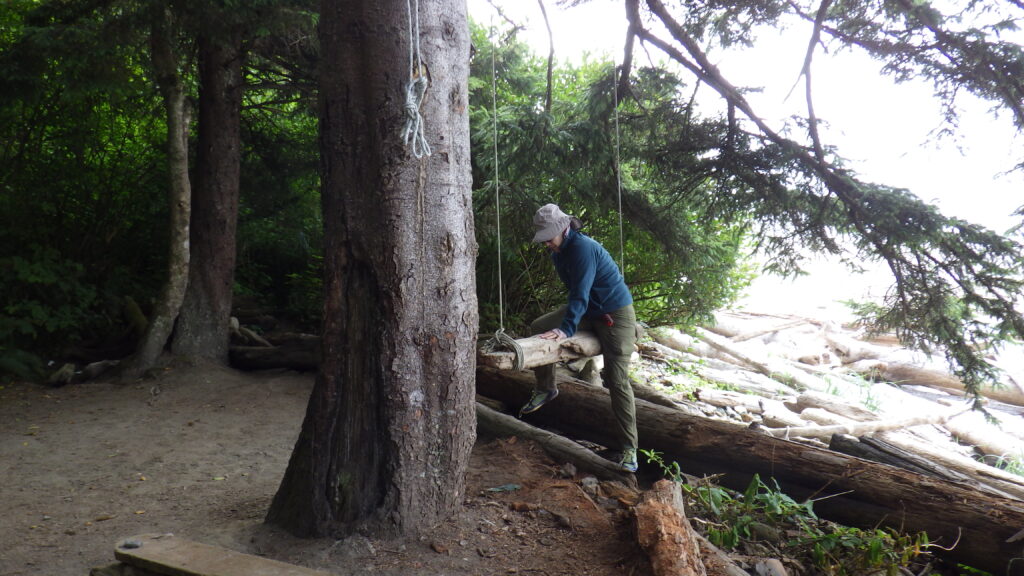
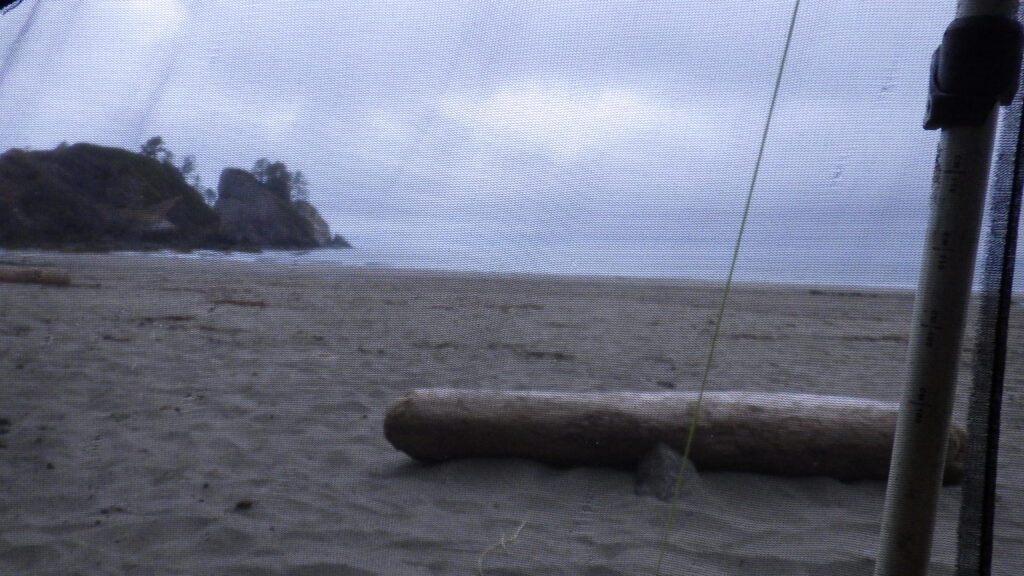
Ambrose and I were both flying a bit high. We’d done it. We’d made it to Shi Shi Beach, and we’d done it with style. I was planning on staying up to watch the sunset, but it wasn’t to be. I did stay awake, but the clouds obscured the sun completely.
Tomorrow was a rest day, and it was supposed to rain. I pulled my as-yet-unused poncho out in case I needed to get out to pee when it was raining. I went to sleep with the thought of not having an alarm in the morning. I didn’t have to get up until I felt like it. What a feeling!